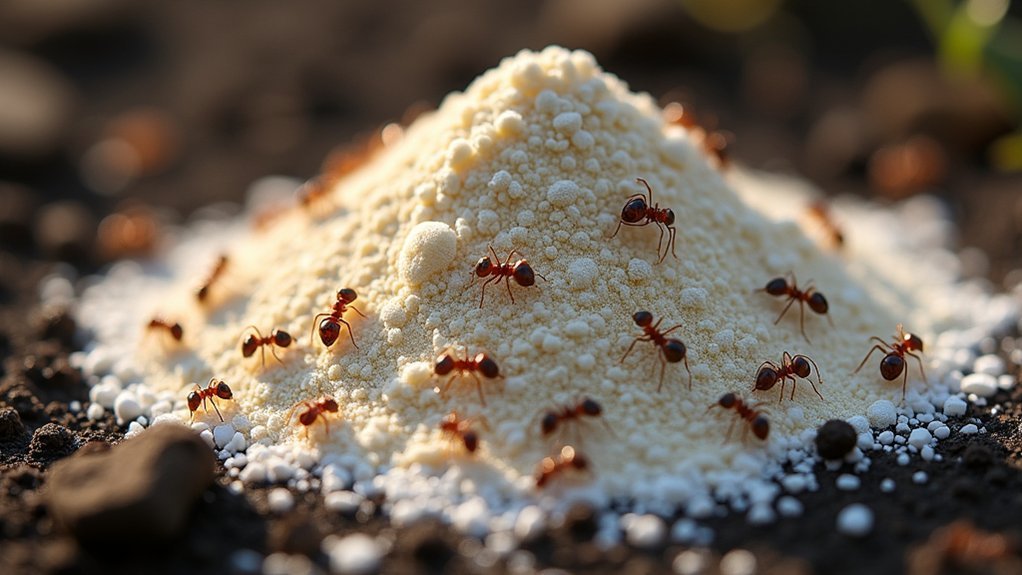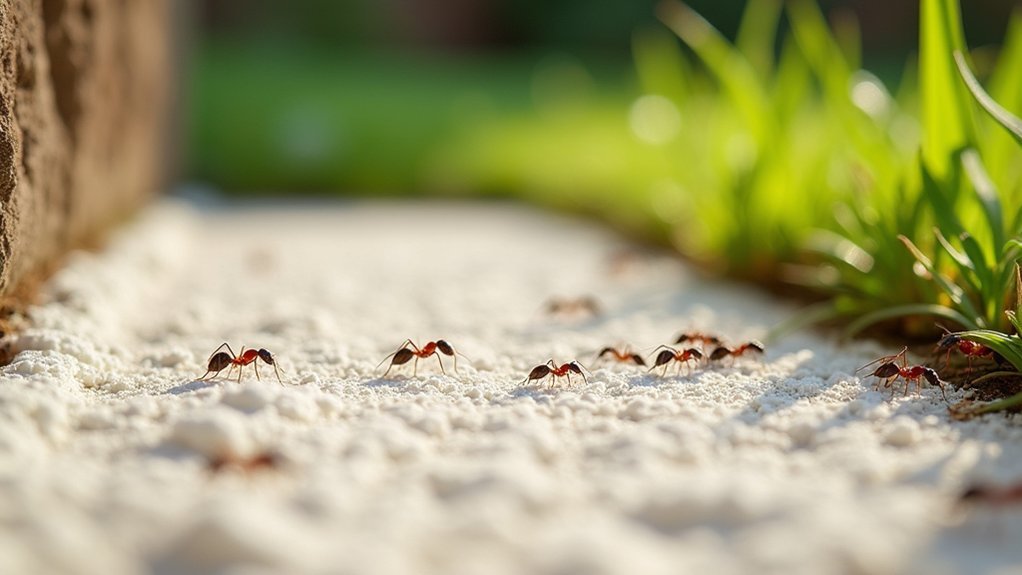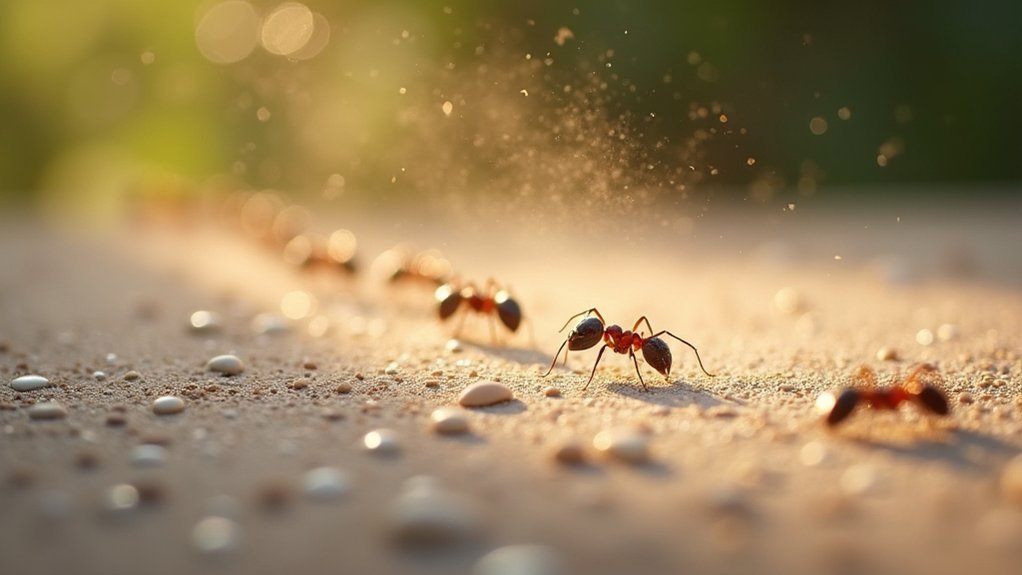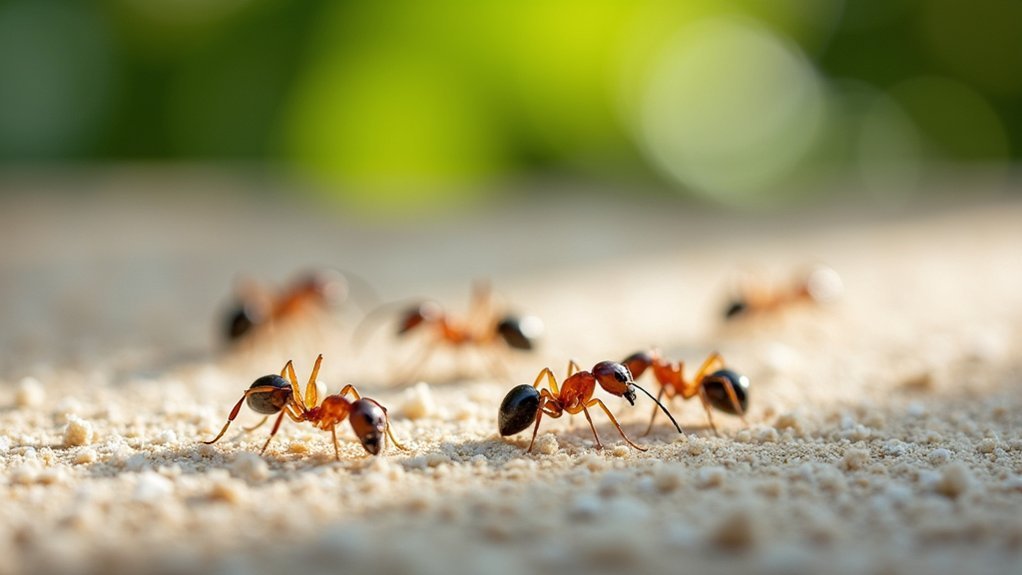Diatomaceous earth destroys ants effectively because its microscopic, razor-sharp edges cut into their exoskeletons, causing rapid dehydration. When ants crawl through this powder, they lose up to 30% of their body weight in water within hours, typically dying within 24-48 hours. You’ll get best results with food-grade DE containing 80-90% silica, applied in thin layers along ant trails and entry points. The mechanical action provides a safer alternative to chemical pesticides with lasting protection.
The Science Behind Diatomaceous Earth’s Ant-Killing Properties

A microscopic battlefield unfolds when diatomaceous earth meets ants. This natural substance, comprised of 80-90% silica, doesn’t poison insects like chemical alternatives. Instead, DE works as a mechanical insecticide, physically disrupting the ants’ bodies rather than affecting their internal systems.
When ants crawl through DE, the razor-sharp microscopic edges of silica particles slice into their exoskeleton of insects. These tiny lacerations might seem inconsequential, but they’re devastating to the ant’s survival. The cuts allow essential moisture to escape from their bodies, triggering rapid dehydration.
Microscopic daggers slice ant armor, creating fatal leaks that transform living insects into desiccated casualties.
You’ll find that affected ants typically die within hours to days as they literally dry out from the inside.
While you won’t eliminate entire colonies instantly, consistent application can markedly disrupt ant populations by targeting their foraging members.
Identifying the Best Type of Diatomaceous Earth for Ant Control
When choosing diatomaceous earth for your ant problem, always select food-grade DE with 80-90% silica content rather than chemically treated pool-grade varieties that can harm your family and pets.
You’ll want to verify the product is finely ground and specifically labeled for pest control use, as smaller particles more effectively penetrate ant exoskeletons.
Remember to wear protective gear during application to avoid inhaling the fine dust particles, which can cause respiratory irritation even with the safer food-grade option.
Food-Grade vs. Pool-Grade
Two distinct types of diatomaceous earth exist on the market, but only one is appropriate for ant control in your home.
Food-grade diatomaceous earth is the only safe choice for pest control around living spaces, as it contains no harmful additives and poses no risk to humans or pets.
When choosing DE for ant invasions, remember these key differences:
- Food-grade DE is safe for humans and can be used in kitchens, gardens, and areas where children play.
- Pool-grade DE undergoes chemical treatment that makes it toxic and unsuitable for pest control in living areas.
- Food-grade options provide effective ant control while remaining environmentally friendly compared to synthetic insecticides.
Always check product labels carefully to verify you’re purchasing food-grade diatomaceous earth for your ant problem, particularly if you’ll be applying it near food preparation areas.
Silica Content Matters
Effective ant control depends considerably on the silica content of your diatomaceous earth. The higher the silica percentage, the more effective your DE will be at eliminating ant colonies. Premium diatomaceous earth contains 80-90% silica, creating microscopic sharp edges that damage ant exoskeletons.
When you’re selecting DE for ant control, look for food-grade products with high silica content. These finely powdered formulations maximize surface contact with ants, quickly penetrating their protective outer layer. The silica particles create micro-abrasions that cause dehydration, leading to ant mortality within hours to days after exposure.
Remember that pool-grade DE contains harmful additives and should never be used for pest control, despite its high silica content. Always choose food-grade DE, which remains effective against ants while staying safe for your family and pets.
Purity and Effectiveness
Food-grade diatomaceous earth’s purity determines its power against ant infestations. When you’re selecting DE for ant control, the higher silica content (80-90%) in food-grade options translates to superior effectiveness. This purity enhances the mechanical action that makes DE deadly to ants.
- Food-grade diatomaceous earth contains microscopic, sharp particles that physically damage ant exoskeletons on contact.
- Unlike pool-grade DE, food-grade options are safe around your family and pets while remaining lethal to ants.
- The mechanical action works without chemicals, causing dehydration in ants by disrupting their protective outer layer.
Remember to store your DE in a dry place and reapply after rain, as moisture reduces its effectiveness. Proper application of high-purity, food-grade diatomaceous earth guarantees your ant control strategy remains potent.
How Diatomaceous Earth Dehydrates Ant Bodies
When ants cross diatomaceous earth, the sharp microscopic silica particles act like millions of tiny knives that slice through their protective exoskeletons.
These microscopic cuts allow essential moisture to escape from the ant’s body while the DE simultaneously extracts additional moisture from the damaged exoskeleton.
You’ll find this lethal drying mechanism works without chemicals, as the physical damage and rapid dehydration typically kill ants within 24-48 hours of contact.
Microscopic Cutting Action
The secret to diatomaceous earth’s lethal impact on ants lies in its microscopic structure. When you apply DE to ant trails or entry points, you’re deploying millions of razor-sharp silica fragments that work like microscopic blades.
These particles, making up 80-90% of DE’s composition, physically attack ants in three devastating ways:
- They puncture the ant’s exoskeleton on contact, creating tiny wounds that compromise their protective barrier.
- The sharp edges scrape away the waxy outer layer that insects use to retain moisture.
- These microscopic cuts accelerate water loss, causing ants to dehydrate within hours.
Unlike chemical pesticides, diatomaceous earth doesn’t poison ants—it physically destroys their ability to maintain hydration. This mechanical killing action makes DE especially effective against ants that walk directly through treated areas.
Exoskeleton Moisture Extraction
Beyond just cutting the exoskeleton, diatomaceous earth’s deadly effectiveness comes from its remarkable moisture-extracting properties. When ants walk through DE, they’re fundamentally walking through a powerful desiccant that actively draws moisture from their bodies.
| Process | Timeframe | Environmental Factor |
|---|---|---|
| Initial Contact | Immediate | Surface Area Covered |
| Silica Absorption | Minutes | Temperature |
| Exoskeleton Drying | 1-2 Hours | Humidity Level |
| Critical Moisture Loss | 4-6 Hours | Air Circulation |
| Complete Desiccation | 12-24 Hours | Direct Sunlight |
The silica in DE, comprising 80-90% of its composition, aggressively pulls moisture from the ant’s exoskeleton. You’ll find this dehydration effect works faster in warm, dry environments where the moisture extraction process accelerates. Once affected, ants can’t maintain their internal water balance and quickly succumb to fatal dehydration.
Lethal Drying Mechanism
Three distinct processes combine to create diatomaceous earth’s lethal drying mechanism in ants. When you apply DE around your home, it triggers a cascade of dehydrating effects that quickly overwhelm these pests.
- Microscopic sharp edges puncture the ant’s protective exoskeleton, creating entry points for moisture loss.
- DE’s high silica content actively pulls water from the ant’s body, causing rapid dehydration.
- The abrasive particles disrupt the ant’s natural moisture retention systems, accelerating water loss.
This triple-action approach explains why ants can lose up to 30% of their body weight in water within just hours of exposure.
The lethal drying mechanism works universally across ant species regardless of their size. Diatomaceous Earth’s effectiveness comes from this unstoppable physical process rather than chemical toxicity.
Application Methods for Maximum Ant Elimination
Effectively applying diatomaceous earth requires strategic placement and proper techniques to maximize ant elimination.
Apply diatomaceous earth in a thin layer along ant trails and entry points where foraging ants will make direct contact with the powder. Use a duster or squeeze bottle for precise application in difficult-to-reach areas.
Create a protective barrier by spreading DE around your home’s foundation, extending 6-12 inches outward to prevent ants from entering.
After application, monitor ant activity for 24-48 hours to evaluate effectiveness and adjust your strategy if needed.
Remember to reapply diatomaceous earth following rain or heavy watering, as moisture reduces its effectiveness by causing particles to clump together and lose their abrasive quality.
Creating Effective Barrier Zones Around Your Home

Creating a protective barrier with diatomaceous earth requires strategic planning to fully safeguard your home from ant invasions. Apply a thin layer of food-grade DE along your foundation, extending 6-12 inches outward to intercept ants before they enter. This creates invisible barrier zones that effectively control ants through direct contact.
Interrupt ant colonies at the source with a thin layer of DE strategically placed around your foundation’s perimeter.
To maximize your ant defense strategy:
- Focus on high-traffic areas including entry points, cracks, and window sills where ants typically travel.
- Create a complete perimeter by distributing DE evenly along baseboards, targeting known ant trails.
- Reapply after rain or watering since moisture reduces effectiveness.
Monitor your barrier zones regularly and adjust application as needed. With consistent maintenance, diatomaceous earth provides continuous protection against determined ant colonies trying to invade your home.
Targeting Ant Trails and Entry Points With Diatomaceous Earth
Successful ant control hinges on strategic application of diatomaceous earth directly where ants travel. By identifying visible ant trails and applying a thin layer of DE along these pathways, you’ll increase contact opportunities that lead to dehydration of the insects.
| Location | Application Method | Reapplication Needs |
|---|---|---|
| Ant Trails | Thin line along path | After disturbance |
| Entry Points | Light dusting around openings | After rain/moisture |
| Baseboards | Continuous thin barrier | Weekly |
| Window Sills | Light application on surface | After cleaning |
| Doorways | Thin line across threshold | After heavy traffic |
Don’t forget to monitor and reapply diatomaceous earth to high-traffic areas regularly. When you consistently target entry points with DE, you’ll create an effective barrier that prevents ants from establishing new trails into your home.
Combining Diatomaceous Earth With Baiting Techniques

You’ll maximize your ant control efforts by combining diatomaceous earth with baiting techniques, creating a powerful dual-action approach that attracts and eliminates ants simultaneously.
Try enhancing your bait stations by sprinkling DE around them, allowing foraging ants to carry the abrasive particles back to their colony while also consuming the bait.
This thorough strategy targets both immediate ant problems and supports long-term colony management, especially when you monitor and refresh your DE-enhanced bait stations regularly.
Dual-Action Ant Control
While diatomaceous earth alone can effectively eliminate ants that cross its path, combining it with strategic baiting techniques creates a powerful dual-action approach that targets the entire colony.
This thorough ant control strategy works on multiple fronts:
- DE damages ant exoskeletons mechanically while baits attract foragers, addressing both physical and behavioral aspects of ant colonies.
- When ants carry contaminated bait back to their nest, they unknowingly transport DE particles, extending its killing power deeper into the colony structure.
- The slow-acting nature of proper baits guarantees wider distribution before mortality occurs, increasing your chances of reaching and eliminating the queen.
For maximum effectiveness, monitor your DE barriers regularly and reapply after rain or cleaning while maintaining fresh bait stations nearby.
Bait Station Enhancements
Enhancing your bait stations with diatomaceous earth creates a powerful one-two punch against persistent ant colonies.
When you combine DE with food attractants, you’ll increase the likelihood that ants will consume the bait and inadvertently transport the abrasive powder back to their nest, potentially reaching the queen.
This strategic combination works by leveraging the ants’ natural foraging behavior. As they navigate through your bait stations seeking food, they’ll contact the DE, which damages their exoskeletons while they simultaneously ingest the bait.
This dual-action approach accelerates results in reducing ant populations.
For maximum effectiveness, place your enhanced bait stations along ant trails and monitor them regularly.
Replenish both the DE and food attractants as needed to maintain consistent control, even against large infestations.
Safety Considerations When Using Diatomaceous Earth
Although diatomaceous earth is a natural pest control solution, proper safety precautions must be followed during its application. Always use food-grade diatomaceous earth for pest control in your home, as pool-grade DE contains harmful chemical treatments unsafe for humans and pets.
When applying DE, protect yourself by:
- Wearing a dust mask to prevent inhalation of fine particles that may irritate your respiratory system
- Using gloves to avoid skin dryness or irritation from prolonged contact
- Applying with a duster tool for controlled distribution in targeted areas
Keep children and pets away from freshly treated areas until the powder settles. While DE is non-toxic, monitor for any adverse reactions.
Avoid contaminating food preparation surfaces by applying DE to cracks, crevices, and entry points rather than countertops or dining areas.
Indoor vs. Outdoor Application Strategies
Successful ant control with diatomaceous earth depends greatly on where and how you apply it, as indoor and outdoor environments present different challenges.
Effective ant elimination hinges on strategic diatomaceous earth placement, with distinct approaches needed for indoor versus outdoor infestations.
For indoor applications, focus on treating ant trails, baseboards, and entry points where ants frequently travel. This direct contact method guarantees the powder adheres to their exoskeletons. You’ll need to concentrate on high-traffic areas where you’ve spotted activity.
Outdoor application requires creating a continuous protective barrier around your home’s foundation, extending 6-12 inches outward. This perimeter prevents colonies from gaining access to your living spaces.
Remember that moisture is diatomaceous earth’s enemy—you’ll need to reapply after rain or watering outdoors, while indoor treatments require revitalizing after cleaning.
Monitor ant activity following both application types to evaluate effectiveness and adjust your strategy as needed.
Dealing With Different Ant Species Using Diatomaceous Earth
While diatomaceous earth offers a universal mechanism of action against ants, different species require tailored approaches for ideal control.
When applying diatomaceous earth, consider the specific habits of the ant species invading your space:
- For pavement and odorous house ants, focus on entry points and visible trails where foraging ants that come in contact with DE will carry traces back to their colony.
- With carpenter ants, target known entry points since they maintain hidden nests that make complete elimination challenging.
- For Argentine ants, apply continuous barriers around your home as their massive colonies require persistent treatment.
Remember that DE works only on direct contact, so you’ll need regular reapplications to effectively impact the entire ant colony, especially after rain or in high-traffic ant areas.
Weather Factors Affecting Diatomaceous Earth Effectiveness
Because diatomaceous earth works through direct physical contact with ants, environmental conditions play a crucial role in its effectiveness.
Moisture is the primary enemy of DE—when wet, the powder clumps together, losing its ability to stick to ant exoskeletons and cut through their protective coating.
Rain and high humidity will greatly reduce diatomaceous earth’s effectiveness, requiring you to reapply after precipitation. Even morning dew can compromise its pest-fighting properties.
Temperature also influences your ant control strategy. Warmer weather increases ant activity, potentially requiring more frequent applications, while cooler temperatures slow ant movement but don’t affect DE’s physical properties.
For maximum effectiveness, apply diatomaceous earth during dry, mild weather conditions, allowing the powder to remain loose and free-flowing—ready to do its destructive work on passing ants.
Monitoring Results and Reapplication Timing
Once you’ve applied diatomaceous earth to combat your ant problem, careful observation becomes your next critical step. Monitor ant activity for 24-48 hours to assess the effectiveness of your initial application.
Be vigilant about watching for alternative trails, as colonies often adapt by creating new routes to avoid treated areas.
Ants are resourceful survivors—always monitor for new pathways as colonies strategically reroute to bypass your defenses.
For ideal effectiveness when monitoring results:
- Check high-traffic areas daily to detect any remaining ant activity
- Reapply DE every few days during active infestations if ants persist
- Always reapply after rainfall or watering, as moisture reduces DE’s abrasive properties
Consistent monitoring helps you determine the perfect timing for reapplication, ensuring continuous protection.
During severe infestations, you might need to reapply DE more frequently until you observe a significant reduction in ant presence around your property.
Comparing Diatomaceous Earth to Chemical Ant Control Methods
As you evaluate your ant control progress, you may wonder how diatomaceous earth compares to conventional pesticides. DE offers a mechanical approach, physically damaging ant exoskeletons and causing dehydration, while chemical ant control methods typically use neurotoxins to disrupt nervous systems.
Unlike chemical options, DE is non-toxic to humans and pets, making it safer for household use around children and animals.
While chemicals often provide faster initial results, DE’s effectiveness persists as long as it remains dry, requiring fewer reapplications over time.
Chemical baits can reach queens deep within colonies, whereas DE primarily targets foraging ants.
You’ll need patience with DE—results typically take hours to days rather than minutes—but you’re choosing a sustainable solution that won’t harm beneficial organisms in your environment.
Frequently Asked Questions
How Long Does It Take for Diatomaceous Earth to Kill Ants?
You’ll see diatomaceous earth kill ants within 24-48 hours after application. It works when they contact it directly. For larger colonies, you’ll need ongoing treatment as not all ants encounter it immediately.
Why Is Diatomaceous Earth Not Killing Ants?
Your DE might not be killing ants because it’s wet, they’re avoiding it, or you haven’t waited long enough. It only kills on contact and won’t eliminate entire colonies without proper application.
Why Do Exterminators Not Use Diatomaceous Earth?
Exterminators don’t typically use diatomaceous earth because it’s slower acting, requires direct contact, loses effectiveness when wet, and doesn’t reach hidden nests. They prefer chemical treatments that target entire colonies more quickly and effectively.
What Are the Downsides of Diatomaceous Earth?
Diatomaceous earth’s downsides include: it’s only effective when dry, won’t reach entire ant colonies, can irritate your lungs if inhaled, may cause skin dryness, and could harm beneficial insects in your garden.
In Summary
You’ve learned why diatomaceous earth works so effectively against ants – it’s a natural, microscopic weapon that destroys their exoskeletons and dehydrates them. By applying it correctly in strategic locations and maintaining your barriers, you’ll create an inhospitable environment for ant colonies. Remember, patience and consistent application are key to successful ant control without harmful chemicals in your home.





Leave a Reply